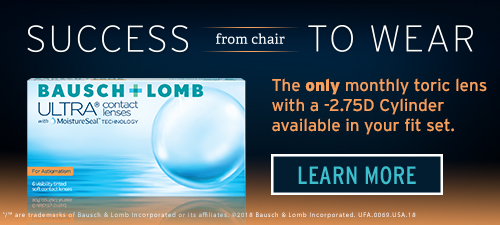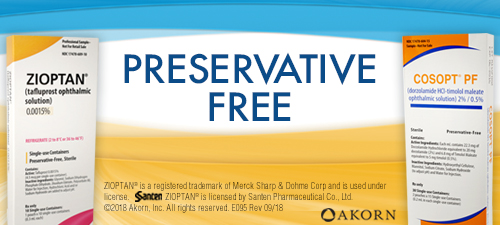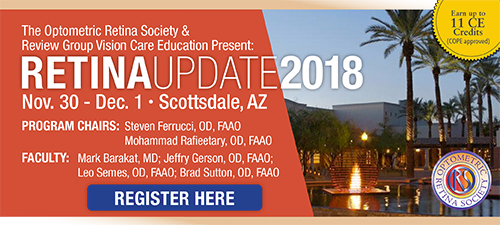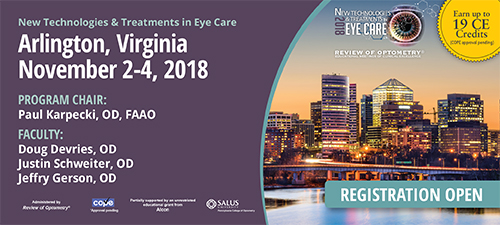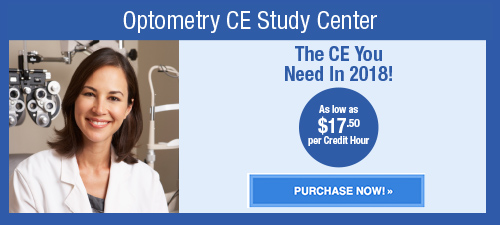
A
weekly e-journal by Art Epstein, OD, FAAO
Off the Cuff: Why Can’t We Get It Together?
After decades of involvement in our profession on many different levels—clinical, academic and political—it has become increasingly obvious to me that we have too many organizations representing optometry’s interests. The profession is drowning in a veritable cornucopia of organizations, acronyms and meetings. We have the AOA, AAO, ARBO, COPE, ACOE, ABO, ABCMO, COVD, OGS, ORS and 50 state societies, and the list goes on and on and on. Many of them don’t even get along. If ever there was an example of too many cooks, this is it.
|
|||||
|
|||
| Influence of Seasons Upon Personal Light Exposure and Longitudinal Axial Length Changes in Young Adults | ||||
Researchers investigated the association between objectively measured ambient light exposure and longitudinal axial length changes (and their seasonal variations) over a period of 12 months in young adults. This prospective, longitudinal, observational study included 43 healthy young adult university students (21 emmetropes and 22 myopes) ages 18 to 30 years. Three axial length measurements were collected at six-month intervals (i.e., at baseline, six and 12 months), in summer and winter to determine the axial eye growth. Personal ambient light exposure data were measured in winter and summer months with wearable sensors, from which the mean daily time exposed to bright (outdoor) light levels (>1,000 lux) was derived. Greater daily bright light exposure was associated with less axial eye growth over 12 months. In summer, myopes exhibited significantly greater changes in axial length (mean change 0.04 ± 0.05mm) compared with emmetropes (-0.01mm ± 0.05mm), but there was no significant difference between refractive groups in winter. Emmetropes also spent significantly greater time in outdoor light levels in summer compared with winter, while myopes spent similar time outdoors during both seasons. Differences in light exposure between summer and winter were also associated with seasonal differences in axial eye growth. In young adults, greater time spent in bright light was associated with slower longitudinal axial eye growth. Seasonal light exposure and axial length changes were dependent on refractive error in this population and also exhibited an inverse relationship. |
||||
SOURCE: Ulaganathan S, Read SA, Collins MJ, et al. Influence of seasons upon personal light exposure and longitudinal axial length changes in young adults. Acta Ophthalmol. 2018; Oct 4. [Epub ahead of print]. |
||||
|
|||
| Managing Normal-tension Glaucoma by Lowering the Intraocular Pressure | ||||
The authors wrote that normal-tension glaucoma (NTG) is a diagnosis assigned when characteristic glaucomatous structural and functional optic nerve defects are present in the setting of intraocular pressures (IOP) measurements below 21mm Hg. Spot IOP measurements are generally obtained in the office during business hours and often determine who is classified as having "normal" pressures. Reduction of IOP has been the cornerstone of anti-glaucoma treatment in primary open-angle glaucoma and NTG, and its therapeutic effect has been well- established.
While several non-IOP related factors have been proposed in the pathogenesis of glaucoma, an effective alternative neuroprotective therapy has not yet come to fruition. A large portion of NTG patients likely has a missed high IOP, the authors explained. NTG patients often have wide diurnal pressure fluctuations, and 24-hour IOP measurements have often captured pressures greater than 21mm Hg. Furthermore, NTG patients have thinner central corneal thickness and lower corneal hysteresis and resistance factors, which may underestimate IOP readings. IOP has been established to be an important causative risk factor in NTG progression. Those with progression despite 30% IOP reduction may not progress with single-digit IOPs. Therefore, in some patients, lowering the IOP below 10mm Hg may be needed to prevent or slow the rate of glaucoma progression, the authors suggested. The authors wrote further that, until an effective pressure-independent neuroprotective treatment for NTG is validated, IOP lowering interventions would continue to be the only rational therapeutic option. |
||||
SOURCE: Razeghinejad MR, Lee D. Managing normal tension glaucoma by lowering the intraocular pressure. Surv Ophthalmol. 2018; Oct 6. [Epub ahead of print]. |
||||
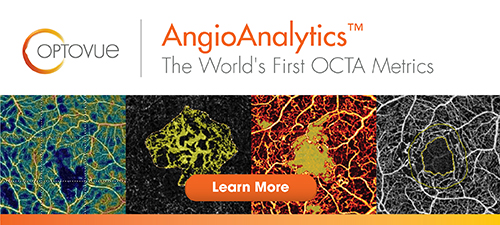 |
||
| Primary Angle-closure Glaucoma with Normal Intraocular Pressure at the First Visit: Its Prevalence and Ocular Characteristics | ||||
Investigators retrospectively reviewed patients with primary-angle closure glaucoma (PACG) in a referral center to investigate the prevalence of normal intraocular pressure (IOP) at the first visit and their ocular characteristics, among patients with PACG. According to untreated IOP, they divided PACG eyes into two groups: those with normal IOP and those with high IOP (>21mm Hg) at the first visit. A total of 160 eyes of 160 Korean PACG patients were included. Sixty percent (97/160) of the patients had normal IOP at their first visits. The PACG patients with initially normal IOP had significantly longer axial length (mean ± standard deviation [SD] 22.99 ± 0.76 vs. 22.74 ± 0.61) and deeper "true" anterior chamber depth (ACD) (2.09 ± 0.27 vs. 1.82 ± 0.33) than those with initially high IOP. Multiple logistic regression analyses revealed that deeper "true" ACD (per 0.1mm, odds ratio [OR] 1.38) and more hyperopic refractive errors (OR 1.48) were independent predictors of initially normal IOP in PACG eyes. The prevalence of disc hemorrhage was higher in PACG patients with initially normal IOP than in those with initially high IOP (29.9% vs. 14.3%). Sixty percent of patients with PACG had normal IOP at their first visits. This suggested that, without gonioscopy, clinicians might misdiagnose PACG as normal-tension glaucoma. Investigators suggested that ACD measurement could aid the diagnosis of PACG because even PACG eyes with initially normal IOP had shallow ACD. |
||||
SOURCE: Oh WH, Kim BG, Kyung H, et al. Primary angle closure glaucoma with normal intraocular pressure at the first visit: its prevalence and ocular characteristics. J Glaucoma. 2018; Oct 8. [Epub ahead of print]. |
||||
| News & Notes | |||||||||||||||||||||||||||||
2018 Academy Resident Travel Fellowship Recipients Announced
|
|||||||||||||||||||||||||||||
| Oculus Releases Smartfield Perimeter Oculus released the Smartfield perimeter, optimized for exams for functional impairment of the central visual field and suited for peripheral measurements. The Smartfield performs standard automated perimetry using an ultra-high luminance LCD display. Its short measurement times make it well-suited for standard screening methods. In addition, software offers a wide array of measurement procedures for diagnostic and follow-up exams. The perimeter requires little set-up space and can be operated in rooms with normal lighting conditions. A translucent lateral eye shield eliminates the need for an eye patch, saving time to prepare for the exam. Learn more. |
|||||||||||||||||||||||||||||
| RightEye Eye-Tracking System Receives FDA 510(k) Clearance RightEye’s vision system has received 510(k) clearance from the FDA for recording, viewing and analyzing eye movements to help identify visual tracking impairment in patients. Using advanced eye-tracking technology and analytics, the RightEye system is the first portable, all-in-one solution for vision-derived health screening, tracking eye movements and correlating them to health issues. The system, which includes RightEye EyeQ tests, reports and training tools, has applications including Functional Vision Screening, Reading Assessments, Sports Vision Assessment & Training and Brain Health. Read more. |
|||||||||||||||||||||||||||||
| Konan Medical Gets FDA 510(k) Nod for objectiveField Perimeter objectiveField is a novel, U.S. FDA-cleared device designed to assess the human visual field in an objective and non-contact manner, without need for manual patient input. Using a patented multifocal pupil objective perimetry method, the perimeter tests both eyes simultaneously in a few minutes. Clinically researched in Australia for more than 12 years with more than 16,000 exams across glaucoma, macular degeneration, diabetic retinopathy and other neuro-visual conditions, intellectual property for objectiveField was acquired by Konan Medical from the Australian National University and includes novel features licensed from Seeing Machines. The technology will be debuted at the American Academy of Ophthalmology Annual Meeting in Chicago, Oct. 26 to 30, at Konan Medical Booth # 2515, and showcased at the American Academy of Optometry in San Antonio, Nov. 7-9. Read more. |
|||||||||||||||||||||||||||||
| SynergEyes Launches Tangible Hydra-PEG Coating in Canada SynergEyes announced that the Tangible Hydra-PEG coating is available in Canada. The polymer coating developed by Tangible Science was launched in the United States in 2017 and received overwhelmingly positive responses, Canadian practitioners also can now can optimize the benefits of Tangible Hydra-PEG on Duette and UltraHealth hybrid lenses. Read more. |
|||||||||||||||||||||||||||||
| Envision Names ODs as Recipients of Low Vision Research & Oculus Awards At the 13th Annual Envision Conference in August, in Wichita, Ks., the Award in Low Vision Research was given to Walter Wittich, PhD, FAAO, CLVT, an assistant professor at the School of Optometry, Université de Montréal. Dr. Wittich is a specialist in dual-sensory impairment and acquired deaf-blindness, and has published more than 50 peer-reviewed articles. In addition, the Envision Oculus Award was presented to Gary Asano, OD, FAAO, a staff optometrist focusing on low vision rehabilitation at Kaiser Permanente in Los Angeles. Read more. |
|||||||||||||||||||||||||||||
|
|||||||||||||||||||||||||||||
|
Optometric Physician™ (OP) newsletter is owned and published by Dr. Arthur Epstein. It is distributed by the Review Group, a Division of Jobson Medical Information LLC (JMI), 11 Campus Boulevard, Newtown Square, PA 19073. HOW TO ADVERTISE |


